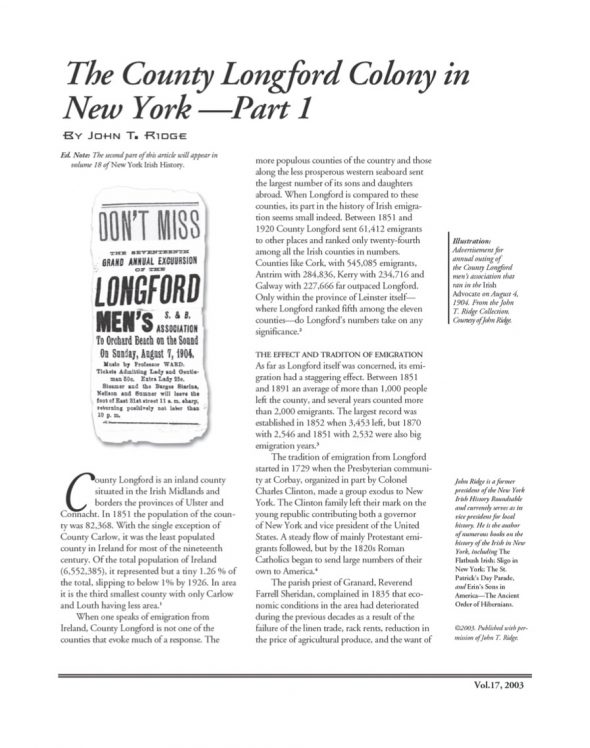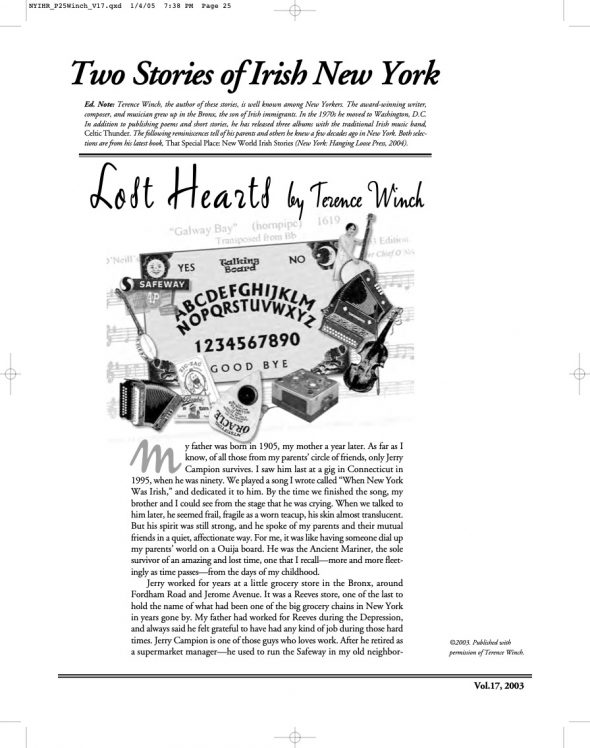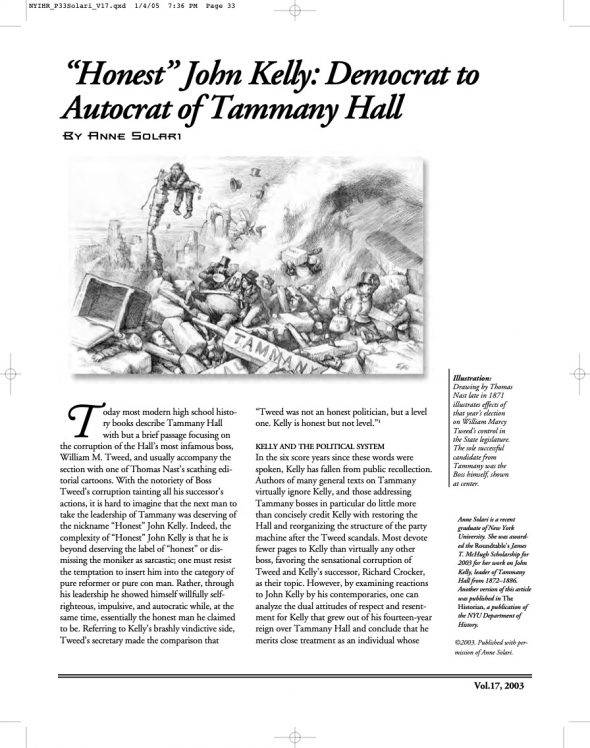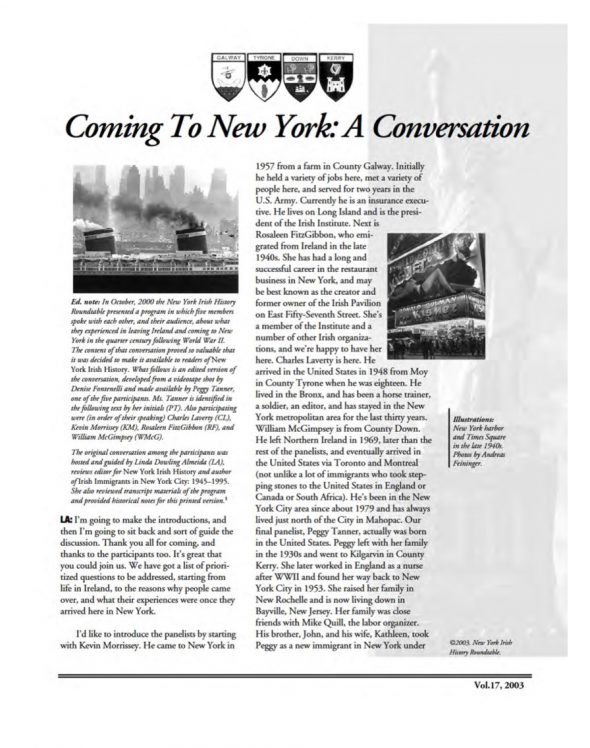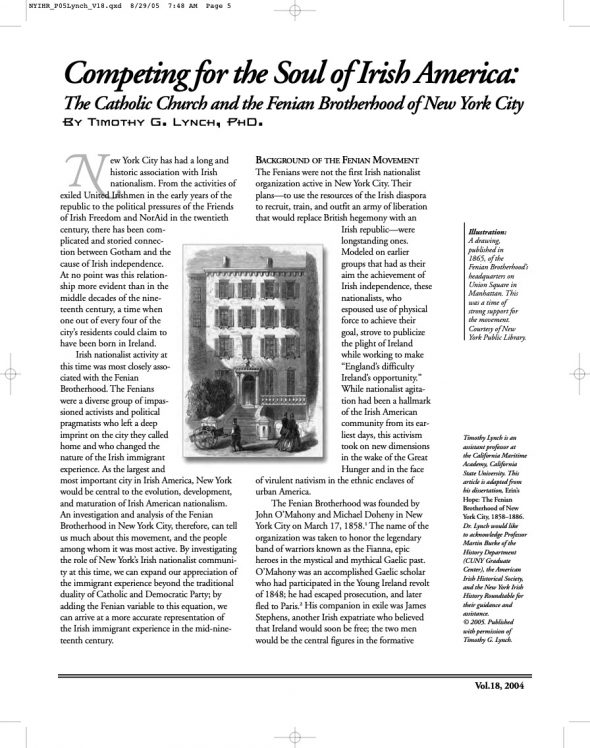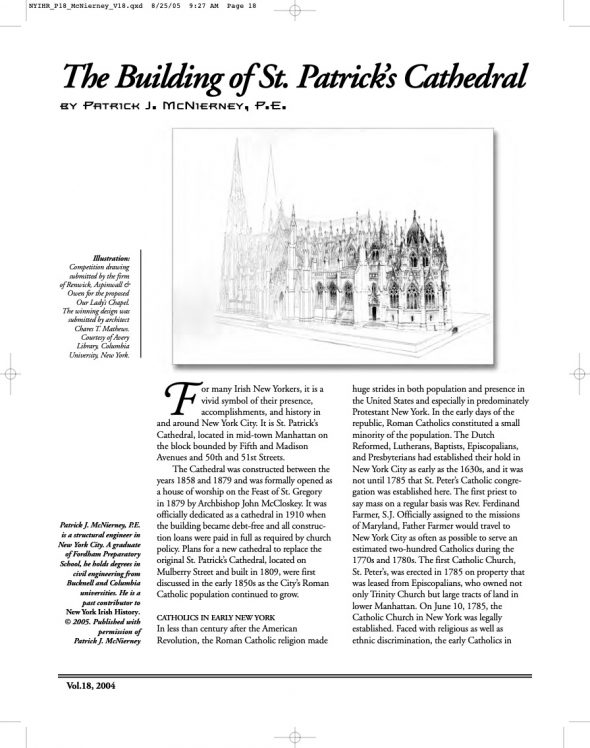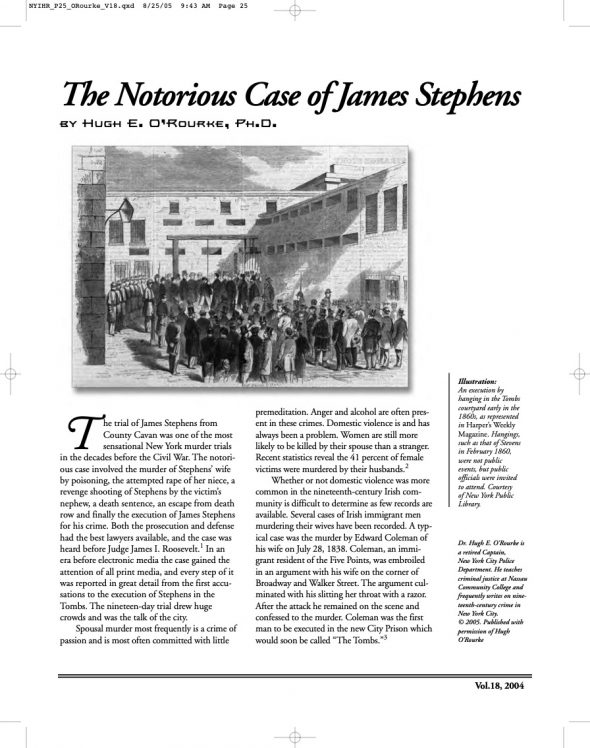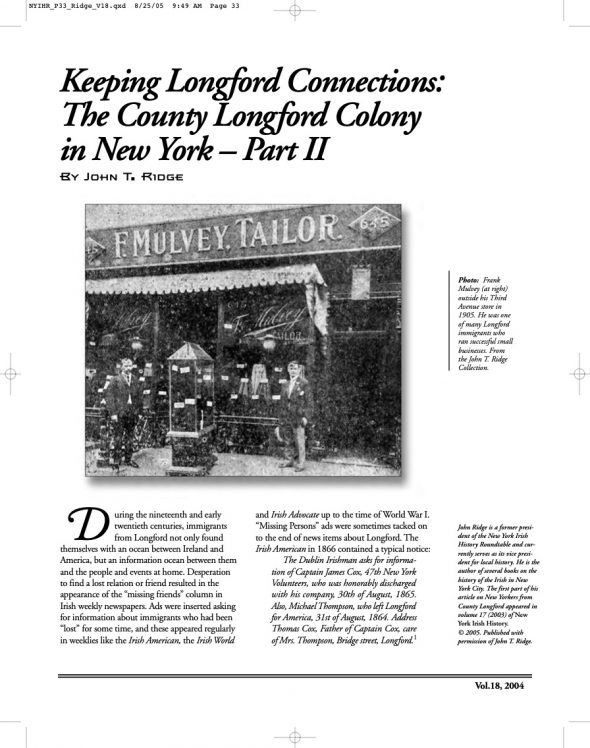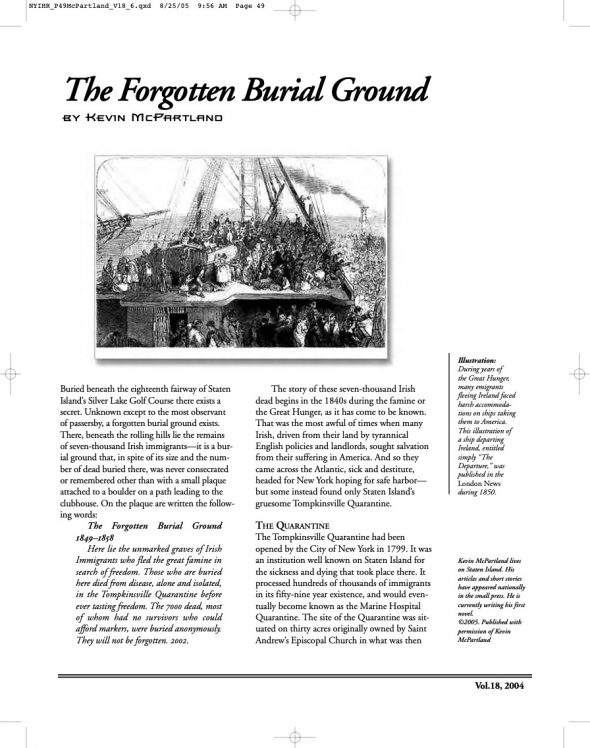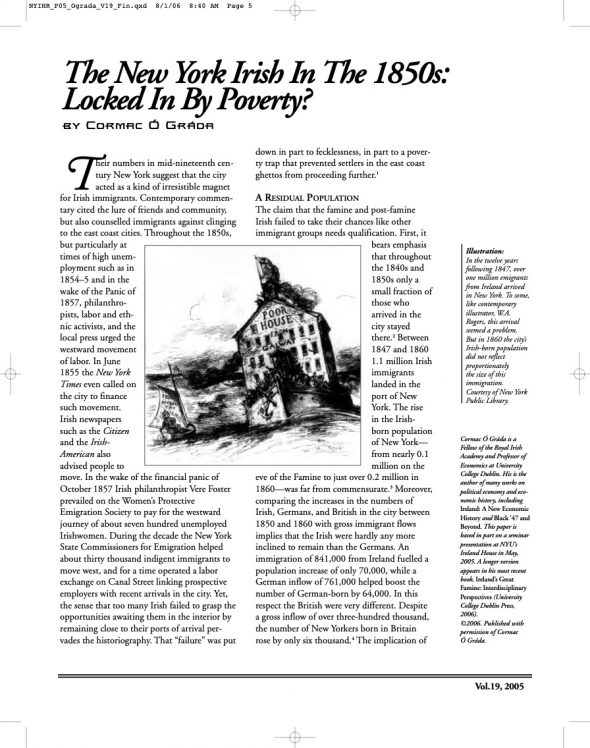New York Irish History Roundtable - Journal Articles
The County Longford Colony in New York—Part 1
Author: John T. Ridge
Publication Year: 2003
Journal Volume: 17
Article Reference: NYIHR-V17-03
The second part of this article will appear involume 18 of New York Irish History.more populous counties of the country and thosealong the less prosperous western seaboard sentthe largest number of its sons and daughtersabroad. When Longford is compared to theseDON'T MISScounties, its part in the history of Irish emigra-to other places and ranked only twenty-fourthIllustration:among all the Irish counties in numbers.
Advertisement for Counties like Cork, with 545,085 emigrants,annual outing ofthe County Longford Antrim with... [Read Full Article]
Two Stories of Irish New York - Lost Hearts and A Row and a Ruction
Author: Terence Winch
Publication Year: 2003
Journal Volume: 17
Article Reference: NYIHR-V17-04
Terence Winch, the author of these stories, is well known among New Yorkers. The award-winning writer, composer, and musician grew up in the Bronx, the son of Irish immigrants. In the 1970s he moved to Washington, D.C. In addition to publishing poems and short stories, he has released three albums with the traditional Irish music band, Celtic Thunder. The following reminiscences tell of his parents and others he knew a few decades ago in New York. Both selections are from his latest book, That Special Place: New World Irish Stories(New... [Read Full Article]
Honest John Kelly - Democrat to Autocrat of Tammany Hall
Author: Anne Solari
Publication Year: 2003
Journal Volume: 17
Article Reference: NYIHR-V17-05
Today most modern high school history books describe Tammany Hall with but a brief passage focusing on the corruption of the Hall's most infamous boss, William M. Tweed, and usually accompany the section with one of Thomas Nast's scathing editorial cartoons. With the notoriety of Boss Tweed's corruption tainting all his successor's actions, it is hard to imagine that the next man to take the leadership of Tammany was deserving of the nickname "Honest" John Kelly. Indeed, the complexity of "Honest" John Kelly... [Read Full Article]
Coming to New York - A Conversation
Author: New York Irish History Roundtable
Publication Year: 2003
Journal Volume: 17
Article Reference: NYIHR-V17-06
Coming To New York: A Conversation 1957 in from a farm in County Galway.
Initially he held a variety of jobs here, met a variety o fpeople here, and served for two years in the U.S. Army.
Currently he is an insurance execudent of the Irish Institute.
Next is grated from Ireland in the late1940s. She has had a long andsuccessful career in the restaurant business in New York, and mayEd. note: In October, 2000 the New York Irish Historybe best known as the creator andformer owner of the Irish Pavilionspoke with each... [Read Full Article]
Competing for the Soul of Irish America - The Catholic Church and the Fenian Brotherhood of New York City
Author: Timothy G. Lynch
Publication Year: 2004
Journal Volume: 18
Article Reference: NYIHR-V18-01
New York City has had a long and historic association with Irish nationalism. From the activities of exiled United Irishmen in the early years of the republic to the political pressures of the Friends of Irish Freedom and NorAid in the twentieth century, there has been complicated and storied connection between Gotham and the cause of Irish independence.
At no point was this relationship more evident than in the middle decades of the nineteenth century, a time when one out of every four of the city's residents could claim to have... [Read Full Article]
The Building of St. Patrick’s Cathedral
Author: Patrick J. McNierney
Publication Year: 2004
Journal Volume: 18
Article Reference: NYIHR-V18-02
For many Irish New Yorkers, it is a vivid symbol of their presence, accomplishments, and history in and around New York City. It is St. Patrick's Cathedral, located in mid-town Manhattan on the block bounded by Fifth and Madison Avenues and 50th and 51st Streets. The Cathedral was constructed between the years 1858 and 1879 and was formally opened as a house of worship on the Feast of St. Gregory in 1879 by Archbishop John McCloskey. It was officially dedicated as a cathedral in 1910 when the building became debt-free and all... [Read Full Article]
The Notorious Case of James Stephens
Author: Hugh E. O’Rourke
Publication Year: 2004
Journal Volume: 18
Article Reference: NYIHR-V18-03
The trial of James Stephens from County Cavan was one of the most sensational New York murder trials in the decades before the Civil War. The notorious case involved the murder of Stephens' wife by poisoning, the attempted rape of her niece, a revenge shooting of Stephens by the victim's nephew, a death sentence, an escape from death row and finally the execution of James Stephens for his crime. Both the prosecution and defense had the best lawyers available, and the case was heard before Judge James I. Roosevelt. 1 In an era before... [Read Full Article]
Keeping Longford Connections - The County Longford Colony in New York, Part II
Author: John T. Ridge
Publication Year: 2004
Journal Volume: 18
Article Reference: NYIHR-V18-04
During the nineteenth and early twentieth centuries, immigrants from Longford not only found themselves with an ocean between Ireland and America, but an information ocean between them and the people and events at home. Desperation to find a lost relation or friend resulted in the appearance of the "missing friends" column in Irish weekly newspapers. Ads were inserted asking for information about immigrants who had been "lost" for some time, and these appeared regularly in weeklies like the Irish American, the Irish Worldand... [Read Full Article]
The Forgotten Burial Ground
Author: Kevin McPartland
Publication Year: 2004
Journal Volume: 18
Article Reference: NYIHR-V18-05
Buried beneath the eighteenth fairway of Staten Island's Silver Lake Golf Course there exists a secret. Unknown except to the most observant of passersby, a forgotten burial ground exists.
There, beneath the rolling hills lie the remains of seven-thousand Irish immigrants - it is a burial ground that, in spite of its size and the number of dead buried there, was never consecrated or remembered other than with a small plaque attached to a boulder on a path leading to the clubhouse. On the plaque are written the following words:... [Read Full Article]
The New York Irish In The 1850s - Locked In By Poverty?
Author: Cormac O Grada
Publication Year: 2005
Journal Volume: 19
Article Reference: NYIHR-V19-01
Their numbers in mid-nineteenth century New York suggest that the city acted as a kind of irresistible magnet for Irish immigrants. Contemporary commentary cited the lure of friends and community, but also counselled immigrants against clinging to the east coast cities. Throughout the 1850s, but particularly at times of high unemployment such as in 1854-5 and in the wake of the Panic of 1857, philanthropists, labor and ethnic activists, and the local press urged the westward movement of labor. In June 1855 the New York Times even called on... [Read Full Article]

